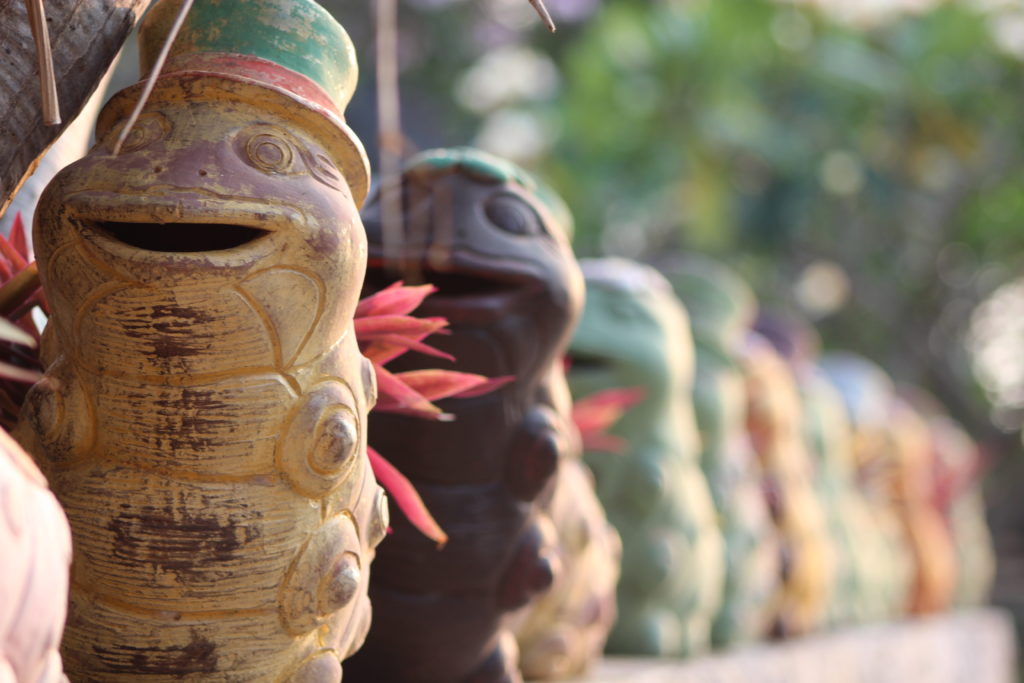(This post originally appeared on Wandering Educators.)
After nineteen years, Ashley and I finally made it back to Thailand. In 1995, we split our time between an environmental NGO and a university biology department in the southern provinces of Trang and Songkhla, but had never had the time, money, and opportunity to get back until now. This article highlights some of the things that we noticed have changed during the interim period.

Bangkok is, well, Bangkok. Big, hot, busy, congested. It hasn’t noticeably changed that much. We stayed away from the hubbub of KSR and Patpong Road, and the threat of political protests at the Democracy Monument, and opted instead to celebrate Christmas in a small hotel (Sala Arun) on the shore of the Chao Phraya River. The view from the room was beautiful, but nighttime at the rooftop bar provided spectacular views of the river and Wat Arun on one side and the sparkling roofs of Wat Pho and the Royal Palace on the other. The only real change that we noticed is that there are much fewer iconic tuk tuks plying the roads. Automobile taxis are now taking over. As much fun as Bangkok could be though, we really couldn’t wait to get out of town and head south.

Photo by Zoey Richards
Southern Thailand was in a period of relative prosperity when we left almost two decades ago. Its prosperity came from helping the country to lead the world in rubber production. People could afford to buy things that were previously out of reach – motorcycles, houses, TVs, cars. But it was also readily apparent that the community infrastructure was not keeping pace. Roads were overcrowded, accidents were plentiful, and hospitals were busy. We saw big changes this time. Rubber is still king, tempered a little by oil palm, but the infrastructure has caught up. Roads have been built or rebuilt to be wider and more plentiful; cities have grown. The city of Trang, for instance, has a new ring road, many new car dealerships, and big box stores at the edge of town.
Photo by Zoey Richards
The other thing that has most noticeably changed is the influence of tourists.In one day on this trip to Trang, we saw more “farang” than we did in an entire year of living there two decades ago. The islands along the coast that were once off the beaten path are now firmly on the tourist radar, drawing people from around the world through town on the way to the beach. The islands used to host the odd resort of modest bungalows that were mostly frequented by Thai tourists. Now the few island beaches that we saw on Koh Mook and Koh Kradan are dominated by expensive resorts. While this no doubt increases the flow of money through the local economy, the coastal fishing villages are traditionally Muslim and maybe not completely appreciative of the influx of the bikini and alcohol culture. The tourists appear to be oblivious that their behavior on the beach in front of their resort should be any different than in the middle of the village a few hundred meters away. It might benefit everyone in the long-run if the resort owners or the villagers nicely let them know.
Environmental impacts from this influx of tourists are apparent in the amount of trash on the islands and the health of the coral reefs. Though trash is an issue throughout Thailand (it seems to be invisible to a lot of people), we saw mountains of old plastic and garbage hidden behind buildings away from the beaches. Though many reefs are still colorful and possess an amazing diversity of fish species, dozens of boats a day are bringing hundreds of snorkelers to swim over them, dropping anchors, trash, and sunscreen. I am no expert, yet it seems that the reefs used to be more extensive.
Not all the environmental news is bad, however, as nature conservation also has had some success stories. One of the primary campaigns of the Yadfon Associationduring Ashley’s tenure there was for the protection and restoration of mangrove forests. These forests are a vital component of native fish ecology that support the livelihoods of traditional fishing villages. Mangroves were being cut down for charcoal production and the land converted to unsustainable tiger prawn farms. Today, the active conversion of mangrove forest has been stopped and many former shrimp farms are being restored back to forest. A few shrimp farms have also been converted to other sustainable forms of fish aquaculture.
As we were leaving Thailand in the 1990s, a national campaign was just beginning to combat deforestation by planting millions of trees throughout Thailand, primarily along road corridors. Sure enough, evenly spaced trees now grace many of the roads that we traveled. Unfortunately for the trees, so are power lines, necessitating regular pruning of the tops of the young trees. Though aesthetically the trees make an obvious difference, more could still be done. The habitat benefits of linear strips of single species foliage are minimal compared to the potential benefits of a diverse range of tree species reforested on large patches of land that could provide internal core habitat (I taught Conservation Biology and Tropical Forest Ecology at Prince of Songkhla University, don’t you know).
But really, we spent much of our time on this trip reconnecting with friends. Big changes had happened there too, as we are all much older and further along in our careers. Kids that were just babies when we left have graduated from college. We celebrated with what seemed to be a banquet every night, enjoying the spicy seafood that southern Thailand is famous for. I hope our next visit won’t have to wait so long!

